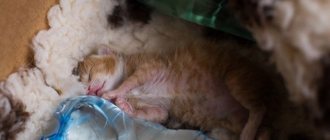How to win the love of a cat, or Cats and 5 languages l
San Sanych Protsenko
In my childhood and youth, I lived with my parents and we had a cat, an ordinary “Central Russian domestic” breed with a character that is now fashionable to call “bitchy.” All the 10 years that we lived together, I was tormented by the question - why does the cat love my father, but only allows me to stroke itself, and even then not always.
The final answer was formed after studying G. Chapman’s book “5 Love Languages” and 2 years of communication with a cat in my own family of 3 people (father, mother and daughter).
Captain evidence suggests that cats are not dogs, whose love for their owner is almost genetically based; a cat’s love is not easy to win – and its choice is not always clear.
The author of the book “5 Love Languages” postulates that harmonious relationships are built on 5 aspects of interaction, conventionally called “love languages”, and each has priority ones, and there are secondary ones. If you address the object of your love in the right language in the right proportions, then reciprocal love is practically guaranteed to you - everything is simple, like everything American - do it once, do it twice, and enjoy the result.
I propose to consider how this scheme works on cats.
Language first. Acts of service.
“By acts of service I mean doing those things that your spouse desires. You look for a way to please her by serving her, express your love by doing something for him."
The most important act of service for a cat is cleaning its litter box; cats are very clean creatures and therefore are very sensitive to their “toilet”. My cat is so spoiled that after relieving herself, she runs to me and meows for me to clean up immediately, closely watching the cleaning process. Perhaps this is one of the most important languages for communicating with a cat; I can’t think of other examples of the “Act of Service.”
Language is second. Physical touch.
“It has long been known that physical touch is one of the ways to convey emotional love. Numerous studies in the field of child development have concluded that young children who were carried, hugged and kissed were emotionally healthier than those who were deprived of physical contact for long periods of time.”
In this aspect, cats are great specialists - there is a well-known theory that cats even learned to purr in the process of communicating with humans; wild cats do not purr. This is a simple and mutually pleasant language for communicating with a cat, the main thing here is not to overdo it - cats often like to be alone, and it is advisable to pet the cat when she wants it, and not you)
The third language. Quality time.
“By quality time, I mean time when you give a person your undivided attention.”
Cats, especially those living indoors, need movement and can also get bored. Any game with her can be useful and exciting - simple “cat and mouse” with a piece of paper, a rag or a string will bring her genuine joy, and even adult cats sometimes like to fool around like kittens or “hunt” you by jumping out of ambush. The best form of play, which my cat came up with herself, is very common among dogs - she brings me her dirty rag mouse, I throw it and the cat, without the “fetch” command, runs after it and brings it back.
The fourth language. Words of approval.
“One way to express love emotionally is to use words of encouragement.
Hidden threat
Even if the animal does not leave the apartment, undergoes routine deworming, is vaccinated and eats heat-treated food, the owner should think about the hygiene of cat caresses:
- Deceptive clean . At first glance, cats seem to be perhaps the cleanest animals on the planet, having inherited the instinct of wild ancestors, hunting from ambush and licking themselves to hide their scent. Murki spend more than half of their waking hours washing themselves, leisurely licking and sorting the fur with their teeth, cleaning their claws and paw pads. A rough tongue, like a brush, absorbs dead hair, skin particles, dirt and skin secretions. Cats are especially meticulous in washing their faces and intimate areas, thus collecting all bodily fluids, as well as external and internal parasites, with their tongue. The owner involuntarily tastes all this, accepting the tenderness of the furry pet.
- The mouth of a predator . Kissing cats is also not acceptable because the animal’s oral cavity is a container for millions of bacteria. Cats do not brush their teeth, so leftover food rots, causing rapid growth of microflora on the mucous membranes of the gums, cheeks and tongue. As a result, animals may experience tartar deposits, caries, stomatitis and gingivitis. Together with saliva, bacteria can migrate to a person if the owner allows the cat to lick his face, and especially his lips.
- Possibility of allergic manifestations. A pathological reaction of the immune system of some people, known as “cat allergy,” develops upon contact with a specific protein compound contained in skin secretions, dead epidermal cells, natural waste, and especially the saliva of the animal. When licking the cat's fur, saliva spreads throughout the cat's body, getting on the owner's skin not only when kissing the face, but also when stroking and grooming the pet.
You can suspect an allergy to cats if the owner is diagnosed with:
- sneezing and clear nasal discharge without an increase in general body temperature (allergic rhinitis);
- persistent dry cough (allergic bronchitis);
- swelling and redness of the mucous membrane of the eyes, watery eyes and itching (allergic conjunctivitis);
- rash on the face and body (allergic dermatitis);
- severe inflammation and itching at the site of a skin scratch or cat bite.
Contact with cat allergen is especially dangerous for people suffering from bronchial asthma.
Also watch the video of what happens if you kiss cats:
The danger that cats pose
There are many other diseases that can be transmitted from animals to humans:
- Bacteria, staphylococci, E-bacillus, salmonella, which are very dangerous, can easily settle in humans.
- Ringworm and other fungal infections, which children are especially susceptible to, are quite difficult to treat.
- Fever or bartonellosis is sometimes transmitted through scratches.
- Careless handling of cat litter can lead to the transmission of toxoplasmosis and other parasites to humans.
The risks are especially high if the pet is sick. But the problem is that you often have no idea that your pet is a carrier of some kind of harmful infection or disease. And you should be even more careful if you are informed about such a disease. Kiss your pet on the head if you really feel like it.
05.05.2019
“Do you know what is the most wonderful thing about our animals? This is their ability to put up with our most strange and unacceptable behavior among their relatives. Animals watch their owners and gradually learn to understand their actions. For the sake of your own peace of mind and for the sake of showing affection to a person you trust.” (Wilma Tigelaar, veterinarian and animal psychologist)
We live in a stressful world, filled with daily bad news on TV, problems in the family and hassle at work, and the ill will of others. We are increasingly withdrawn into ourselves and are ready to fight back at any moment.
Is it possible to kiss a cat on the lips?
They say that a cat's mouth is much more hygienic than a human's. In addition, the bacteria that settle in the mouth are similar to human ones.
However, some of the bacteria in an animal's mouth can cause gum disease. After all, a pet is, first of all, a predator, and it eats animals and insects, which, in turn, can be carriers of unpleasant, even dangerous diseases.
Even this circumstance should warn a person against excessive kissing with his pet.
Of course, you can take some steps to protect yourself, such as brushing your pet's teeth or using mouthwash, but it's safer to not kiss your pet at all.
The reasons are mystical
It is believed that cats are guides to the other world. The Egyptians believed that the animal could ward off evil spirits, and they worshiped cats as a deity. In Europe, for a long time, cats were considered assistants to witches, so they were often burned at the stake along with their mistresses.
One of the reasons why you shouldn't kiss cats on the face is the danger of becoming its slave. It is believed that the owner who kissed the cat will serve her until death. He will fulfill all her whims and stop noticing other household members.
According to another belief, a person who kisses a cat gives her all his vitality. The more often kisses fall on the pussy, the weaker and more painful its owner becomes.
Another superstition is that cats allegedly lose their sense of smell when kissed. This is another argument why cats should not be kissed. In practice, this situation has never been confirmed by any veterinarian. Most often, the pussy loses its sense of smell due to a common runny nose (this also happens in cats). Another reason may be the age of the animal.
The benefits of contact with a cat
Of course, due to certain circumstances, it may be necessary to avoid close contact with the animal. But it cannot be denied that it can really improve a person’s health - good mood, lowering blood pressure, strengthening the immune system.
People who have an animal as a companion are happier and healthier. Children who grow up in constant contact with a pet are less likely to develop allergies than those who are provided with almost sterile conditions. Perhaps this is due to the formation of the body’s defenses against the effects of viruses and bacteria, which the child encounters very early.
Viruses and infections
The only good reason why you shouldn’t kiss cats on the nose is the pet’s possible illness. Four-legged animals and their owners have a number of common ailments, and some of them are transmitted through close contact.
From seemingly healthy domestic cats, the owner can become infected with:
- Protozoa bacteria - do not pose a threat if the immune system is not suppressed.
- Staphylococcus - some types are dangerous to humans.
- Salmonella is dangerous to humans, but cats are rarely its asymptomatic carriers.
- Fungi of various natures. The most common fungus transmitted from cats to humans is ringworm. Fungi are contagious, cause discomfort, require long-term treatment, but do not pose a serious danger.
There is such a thing as “cat scratch fever.” The formulation implies an acute reaction of the human immune system to an infection that has entered the skin through a scratch or bite. The causative agent is the bacterium Bartonella, which can be detected in a pet through a blood test.
Toxoplasmosis can also be transmitted through kissing, but the likelihood is extremely low. Toxoplasma is found in animal feces, but immediately after entering the external environment, it lies dormant. After about 3 days, under favorable circumstances, toxoplasma becomes active. Considering all the nuances, the risk of contracting toxoplasmosis is much higher if a person comes into contact with sand from uncovered sandboxes.
Precautionary measures
If it is impossible not to kiss an animal, then you should at least limit yourself to your pet. The owner is aware of his health. Never do this to an outdoor cat or any other person's cat.
You should not come into contact with a growling animal, or deliberately kiss an animal that does not like kisses.
It is important to ensure regular veterinary supervision of your pet and timely vaccinations so that it remains healthy.
After interacting with your pet, you should definitely wash your hands, especially if you plan to prepare food.
It's better to pet your cat more often. After all, unlike a human, she does not crave kissing, which is confirmed by the animal’s actions after the kiss: the pet immediately begins to wash itself with its paw.
Prevention measures
In order not to “catch” dangerous zooanthropotic diseases from your own cat, it is enough to follow simple preventive measures:
- Your pet should be regularly dewormed, treated for external parasites, and vaccinated against all known viral infections, including rabies.
- Closely monitor the health of the animal; at the first signs of illness or inappropriate behavior, immediately contact a veterinary clinic.
- Never touch newborn kittens or the female if she is behaving aggressively. Keep children away from them.
- Do not separate fighting cats; you should not approach them at all - at this moment a person can be seriously injured.
- Never tease a cat, play with your bare hands, or throw your pet out of balance.
- You should not touch animals when they sleep, eat, or wash themselves.
- You should never kiss cats - neither domestic pets, nor, especially, strangers or street ones.
In addition, it is necessary to observe the rules of personal hygiene and clean and disinfect the cat's litter box every day, wash water and food bowls.
Wet cleaning of the house, if a pet lives in it, should also be carried out every day, and regular general cleaning - with the use of disinfectants and the use of a steam generator.
Cat Kiss: Are you really kissed by your cats and pussies?
Cat Kiss: Are you really kissed by your cats and pussies? Independence is a sign of a true cat breed, as is commonly believed. However, with all the craving for freedom and equanimity, domestic pussies often express affection to their, sometimes extremely loving, owners. Does the cat lick your cheeks, nudge them with its nose, and therefore kiss you? It's a delusion. Human caresses are not always similar to the tenderness of pets. The cat family has its own views on showing love. photopin.com
People come up with names for their kisses and attach special meaning to the touch of their lips - affectionate, friendly, romantic. When we see that cats, meeting in a common area, sniff each other nose to nose and lick their faces, we think that they are kissing. And if a cat acts this way towards us, it seems that she is also kissing a person. In fact, there are many reasons for this behavior in cats. Cats have special glands on their faces that help them mark their territory. By rubbing together, cats spread their own scent within the cat family and divide society into friends and foes. The same thing happens when communicating with a person. If a cat rubs its nose, muzzle, and teeth against your face, it means that it is marking you as “one of its own,” and you are allowed to be on its territory.
If the cat started licking its owner, then perhaps it just seemed to her that you were tasty, because on your face she smelled traces of lunch or dinner in the form of aromas and small crumbs. In addition, cats are curious animals. And if they smell a new perfume or an unfamiliar smell that interests them, they will certainly come to rub it.
Sometimes cats may lick out of affection if they think you're not grooming yourself carefully enough. Usually this behavior is typical for them within a cat pair or family. Animals can lick each other and butt heads, and mother cats lick kittens to eliminate excess odor and protect children from enemies. All these actions can be considered a sign of love and friendship, but not directly a kiss. And if you watch your pet longer, you will see that both kittens and adults love to taste different objects - from textiles to wood and rubber. And at these moments no one will think that cats are kissing furniture.
Dangerous neighborhood
By receiving good nutrition and regular grooming, your pet can look completely healthy: well-fed sides, radiant eyes, shiny coat. However, it can be a carrier of pathogenic particles dangerous to humans, including viruses, bacteria, fungal microflora and parasites.
If a cat has access to the street and “walks on its own,” then the likelihood of bringing infection into the house on its paws and fur increases tenfold. Dirty travel through garbage cans and basements, eating garbage, contact with rats and unkempt stray creatures increases the risk of transmitting pathogens of dangerous diseases to owners:
- Rabies . The deadly virus usually enters the bloodstream through the bite of a sick animal. However, there have been cases of infection through saliva that gets onto the wound surface of the skin or mucous membrane. In the wild, the main source of the disease is foxes, and in the city - stray dogs and cats. The virus spreads along nerve fibers and affects the central nervous system, leading to aggressive behavior, paralysis and death. Veterinarians warn: you should never touch, much less pick up or press an unfamiliar cat to your face. The closer the site of initial penetration of the pathogen is to the head, the shorter the incubation period and the less time to take preventive measures and administer a life-saving vaccine.
- Toxoplasmosis . The causative agent of toxoplasmosis is the microscopic parasite Toxoplasma gondii, which enters the body through contact with infected animals, their blood, entrails and feces, as well as through eating poorly cooked or fried meat. If a pet is a carrier of toxoplasma, the owner can easily become infected by changing the litter in the cat's litter box and forgetting to wash their hands afterward. Some people have asymptomatic toxoplasmosis, while others experience a slight increase in temperature, conjunctivitis, lethargy, swollen lymph nodes, and dysfunction of the liver, heart, and nervous system. Toxoplasma poses a particular danger to pregnant women, causing intrauterine fetal death, serious developmental disorders and the birth of an oligophrenic child.
- Salmonellosis . This is a highly contagious infectious disease of animals caused by bacteria from the genus Salmonella and affecting mainly the digestive and respiratory systems. In young animals, the disease is severe, with general intoxication, fever, signs of acute gastroenteritis and bronchitis. A pet can become infected with salmonella through contact with sick pets, birds and harmful rodents. If sanitary standards are not observed at poultry farms, poultry carcasses and eggs become the source of the disease. A person runs the risk of getting salmonellosis by caring for a sick kitten or eating meat products that have not passed veterinary control.
- Chlamydia . In cats, the intracellular bacterium Chlamydophila felis most often affects the eyes, leading to chronic conjunctivitis. In babies from 1 to 3 months, severe inflammation of the mucous membrane of the eyes and profuse lacrimation are accompanied by decreased activity, runny nose, swelling of the throat and bronchitis. Mature cats become infected through sexual contact, newborn kittens - when passing through the female's birth canal. In humans, the course of feline chlamydial conjunctivitis has a lubricated form and proceeds easily. Infection is possible through contact with a carrier animal. For treatment, eye ointments containing antibiotics are used.
- Dermatomycoses . Fungal infections of the skin, known as ringworm, lead to redness, itching, dandruff, bald patches and brittle hair. The course of the disease is complicated by the addition of a pyogenic infection. Young children are most sensitive to dermatomycosis due to instability of the immune system and non-compliance with mandatory hygiene rules. If symptoms of the disease are detected in a cat, treatment should be started immediately, and all family members should undergo a preventive examination by a dermatologist.
- Helminths . Cats can be hosts to several types of parasitic worms (worms), which live primarily in the intestines, but cause intoxication of the entire body. Kittens are most often infected with roundworms (nematodes), the most common of which are roundworms. Their number can be so great that the intestinal wall ruptures and the baby dies from peritonitis. Adult animals are infested with tapeworms, the most dangerous of which is echinococcus. In the human body, the larva travels through the bloodstream into the liver and forms blisters there, in which it slowly develops and grows. Cats become infected with helminths from each other, or by eating raw meat, liver, or fish with microscopic larvae. Freshwater bodies of water are especially unfavorable, so it is recommended to thoroughly boil the catch from there. Worm eggs are released into the external environment with feces and often remain on the animal’s fur, so a person can become a carrier of helminths during daily interaction with a cat. As a preventative measure, you should regularly give your pet antihelminthic drugs and avoid feeding poor-quality food.











